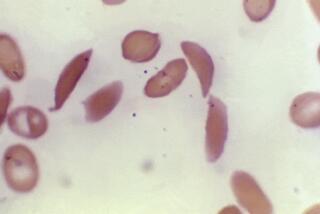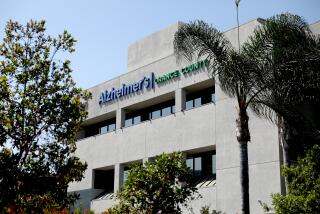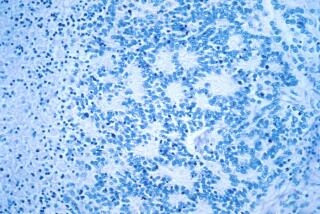Researchers Encouraged by Cancer Drugs : Medicine: Treatment produces remission of hairy cell leukemia in 85% of patients in Scripps Clinic test.
- Share via
SAN DIEGO — In two separate research projects, scientists in San Diego and at the National Cancer Institute reported Monday encouraging results with two new drugs in the treatment of a relatively rare, lethal form of leukemia.
In a preliminary study, a single treatment with a new drug apparently has caused complete remissions among many patients stricken with hairy cell leukemia, a Scripps Clinic researcher reported.
Reporting on results of a trial with 144 patients with hairy cell leukemia, Dr. Lawrence Piro said 85% of those treated with the new drug underwent complete remission of the usually deadly disease. An additional 12% experienced partial remission and 2% did not respond to treatment using the drug 2-CdA, or 2-chlorodeoxyadenosine. The remaining patients died of unrelated causes.
The patients have been monitored for signs of the disease from 14 to 78 months--or a median of two years--after being treated with a continuous dose over seven days, Piro said during a meeting of the American Society of Clinical Oncology in San Diego.
“Any time you have a treatment where one infusion is able to induce a high rate of remission, it becomes very desirable,” said Piro, director of Scripps Clinic’s Green Cancer Center. “Have we cured these patients? Only time will tell us.”
Piro first reported success with 2-CdA two years ago in the New England Journal of Medicine after a trial involving 12 patients. The results this week represent the largest trial of the drug.
Hairy cell leukemia is a relatively rare but fatal malignancy affecting the blood and bone marrow. As the disease develops, abnormal lymphocytes--white blood cells--begin growing uncontrollably. Eventually, they take over the bone marrow, wiping out its ability to produce clotting and infection-fighting cells. The disease earned its name because the cancer cells look hairy when examined under a microscope.
The leukemia afflicts about 6,000 Americans, with 500 to 600 new cases each year. Interferon usually has been used to treat the disease, but doctors have begun to suspect shortcomings with that drug.
According to data presented here, two drugs--2-CdA and deoxycoformysin, or DCF--appear more effective than interferon in battling hairy cell leukemia. The drug 2-CdA is under review by the U. S. Food and Drug Administration and is not widely available; DCF is available as a second line of defense when interferon fails.
National Cancer Institute investigators at the conference presented data from a separate study showing they found that DCF caused complete remission in 68% of 152 treated patients. In the same study, the remission rate was 11% among the 153 patients treated with interferon, said Dr. Michael R. Grever, the NCI’s associate director of its developmental therapeutics program.
In the randomized NCI study, patients were followed a median of 38 months after being treated for between six months to one year with DCF, also known as pentostatin, Grever said.
“The disease doesn’t go away on its own--I don’t think there’s any question that the drugs are causing complete remission,” Grever said. “We have two very good drugs (2-CdA and DCF) . . . . Whether or not we’ve licked hairy cell leukemia is going to take time to see how well these drugs do, long-term.”
The question about whether either drug represents a complete cure remains unanswered because the disease can be slow to develop. About 10% of those afflicted with hairy cell leukemia live a decade without needing intervention, Grever said. Others get sick within a few years.
The Scripps study did not include a control group but Piro and his colleagues are clearly encouraged by their findings. For those who underwent complete remission, the researchers found no evidence of the cancer cells in their bodies for up to 78 months. Those in partial remission exhibited some decrease in cancer cells.
Piro touts the drug as appealing because it is not only effective, but it lacks such side effects as nausea and vomiting that can accompany DCF and standard chemotherapy.
Fever is the most common side effect that researchers have found among 2-CdA patients. Piro believes the cells are so rapidly killed by the drug that they release a naturally occurring substance that regulates cell growth.






